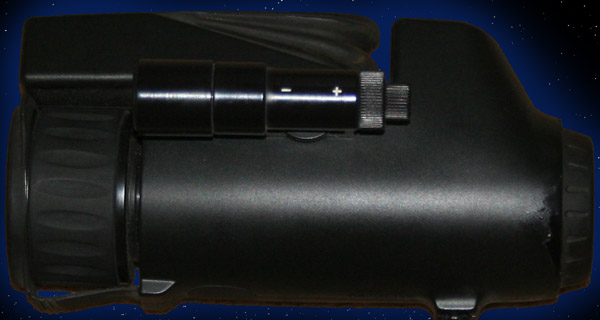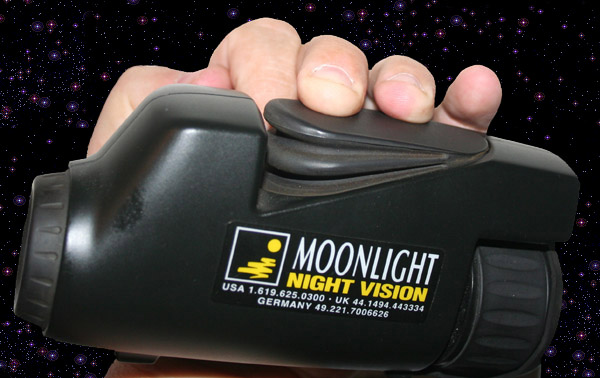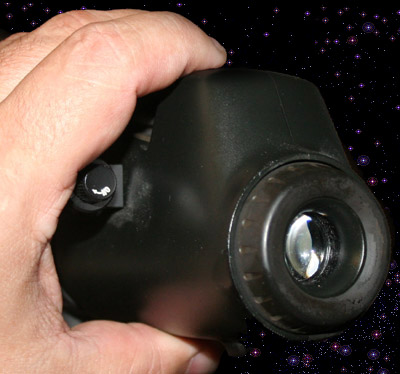The Safari 
| Tube |
Lens |
Power |
Dimensions/weight |
Construction |
Type |
| Gen. I (20mm) |
50mm F 1.5 (2.4X) |
Squeeze (Piezo) |
5.9"x2"x3" /15oz. |
Plastic w metal I.R. |
Night viewer |
This is a good general purpose
scope, and a lot of fun. This is a medium quality night scope which sees
noticeably better than a pair of night adapted eyes. The rated gain of
the tube is around 1000x-1500x, but the total system gain is down to
around 90x. In my purely subjective opinion, I would say this is about a
two F-stop improvement over the totally night adapted eye. The I.R.
illuminator is pretty much a requirement for this generation of scope,
if used in deep darkness. The imager is powered by squeezing a
rubber bellows at the top if the scope. This charges the imager tube, which will stay lit for several minutes, before requiring another
charge. Though the scope itself needs no power
source, the I.R. illuminator takes a single DL1/N lithium battery. This
is an odd size and voltage (3 volts), and I had to try about four
different places before finding one that carried them. The battery is
about the diameter of a standard camera type, but it is twice as thick.
The 3 volt requirement means that you can not take standard button
batteries and stack them to get the width. There are other I.R. sources.
You can get filters for flashlights, headlights, and spotlights, but
these produce a great deal of heat, making the direct I.R. source the
preferred method. The included illuminator is not a very "clean" source
of I.R., and there is a small, but noticeable amount of ruby colored
light emanating from it. The objective, and ocular both have focusing
adjustments. These adjustments, and the squeeze power generator, are the
only controls on the unit. The detachable I.R. source has a rotating
on/off switch.
tube, which will stay lit for several minutes, before requiring another
charge. Though the scope itself needs no power
source, the I.R. illuminator takes a single DL1/N lithium battery. This
is an odd size and voltage (3 volts), and I had to try about four
different places before finding one that carried them. The battery is
about the diameter of a standard camera type, but it is twice as thick.
The 3 volt requirement means that you can not take standard button
batteries and stack them to get the width. There are other I.R. sources.
You can get filters for flashlights, headlights, and spotlights, but
these produce a great deal of heat, making the direct I.R. source the
preferred method. The included illuminator is not a very "clean" source
of I.R., and there is a small, but noticeable amount of ruby colored
light emanating from it. The objective, and ocular both have focusing
adjustments. These adjustments, and the squeeze power generator, are the
only controls on the unit. The detachable I.R. source has a rotating
on/off switch.
Scopes of this type are an aid
to night vision, but are not true night vision scopes without the use of
an I.R. source, which is the reason that most first generation scopes
include one. The plastic body is not up to military standards, and the
device must be treated with a certain amount of care. Though the optics
are good, the image tube introduces a considerable amount of distortion,
particularly around the outer edges. This is normal for a first
generation (cascade type) tube, and is no reflection upon the quality of
this particular model. My tube has a couple of pinhole black spots,
which is a normal variation of all 3 (possibly all 4) generations of
tubes. The pinholes are not visible in the example photos, and are
generally not noticeable at all except when moving the scope. Scopes of
this type sell for around $150-$230 depending upon the make, model,
seller, and the luck of the buyer. I paid around $130, and consider it
to have been a pretty good deal. The scope is light, handy, and the
plastic body is robust enough for casual civilian use.
 Like most of the low end night vision devices out there, this unit is
made in Russia. Russian night vision devices began to hit the American
market right after the fall of the old Soviet Union. Though not up to
the quality of American made units, the Russian scopes were actually
cheap enough to be affordable to the casual user. Availability has
created a reasonably strong demand for these types of devices. Where, 20
years ago, few would have had any interest in owning a night scope,
considering such a thing to be a gadget, or some sort of exotic piece of
espionage gear, today police departments, hunters and outdoorsmen
consider night vision gear to be useful, if not essential pieces of
equipment.
Like most of the low end night vision devices out there, this unit is
made in Russia. Russian night vision devices began to hit the American
market right after the fall of the old Soviet Union. Though not up to
the quality of American made units, the Russian scopes were actually
cheap enough to be affordable to the casual user. Availability has
created a reasonably strong demand for these types of devices. Where, 20
years ago, few would have had any interest in owning a night scope,
considering such a thing to be a gadget, or some sort of exotic piece of
espionage gear, today police departments, hunters and outdoorsmen
consider night vision gear to be useful, if not essential pieces of
equipment.
These are often advertised as gen1+ scopes, due to the
cascading image tubes used in their construction. A cascading image tube
is essentially two (or more) tubes used in tandem, which is why there is
often so much distortion on this type of unit. Distortion and all, this
is an amazing piece of technology, at an amazing price, when considering
what it does, and how much such a device would have cost a decade or so
ago. Tube life, on these units is said to be around 2500 hours of use.
This may not sound like much, but calculates to being an hour of use per
day, every day, for about seven years. The average owner will probably
put less than 100 hours a year on one of these scopes, meaning that most
units sold today will probably be around for some time to come.
Sample images from this scope are on my main night vision page, both in
the example section, of a first gen unit, and in the main section, as
the two pictures of the tavern scene. I have had this scope for several
years now, and have never had a bit of trouble with it. |